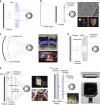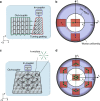Augmented reality and virtual reality displays: emerging technologies and future perspectives
- PMID: 34697292
- PMCID: PMC8546092
- DOI: 10.1038/s41377-021-00658-8
Augmented reality and virtual reality displays: emerging technologies and future perspectives
Abstract
With rapid advances in high-speed communication and computation, augmented reality (AR) and virtual reality (VR) are emerging as next-generation display platforms for deeper human-digital interactions. Nonetheless, to simultaneously match the exceptional performance of human vision and keep the near-eye display module compact and lightweight imposes unprecedented challenges on optical engineering. Fortunately, recent progress in holographic optical elements (HOEs) and lithography-enabled devices provide innovative ways to tackle these obstacles in AR and VR that are otherwise difficult with traditional optics. In this review, we begin with introducing the basic structures of AR and VR headsets, and then describing the operation principles of various HOEs and lithography-enabled devices. Their properties are analyzed in detail, including strong selectivity on wavelength and incident angle, and multiplexing ability of volume HOEs, polarization dependency and active switching of liquid crystal HOEs, device fabrication, and properties of micro-LEDs (light-emitting diodes), and large design freedoms of metasurfaces. Afterwards, we discuss how these devices help enhance the AR and VR performance, with detailed description and analysis of some state-of-the-art architectures. Finally, we cast a perspective on potential developments and research directions of these photonic devices for future AR and VR displays.
© 2021. The Author(s).
Conflict of interest statement
The authors declare no competing interests.
Figures
















References
-
- Cakmakci O, Rolland J. Head-worn displays: a review. J. Disp. Technol. 2006;2:199–216. doi: 10.1109/JDT.2006.879846. - DOI
-
- Choi S, Jung K, Noh SD. Virtual reality applications in manufacturing industries: past research, present findings, and future directions. Concurrent Eng. 2015;23:40–63. doi: 10.1177/1063293X14568814. - DOI
-
- Li X, et al. A critical review of virtual and augmented reality (VR/AR) applications in construction safety. Autom. Constr. 2018;86:150–162. doi: 10.1016/j.autcon.2017.11.003. - DOI
Publication types
LinkOut - more resources
Full Text Sources
Other Literature Sources
Research Materials
Miscellaneous

